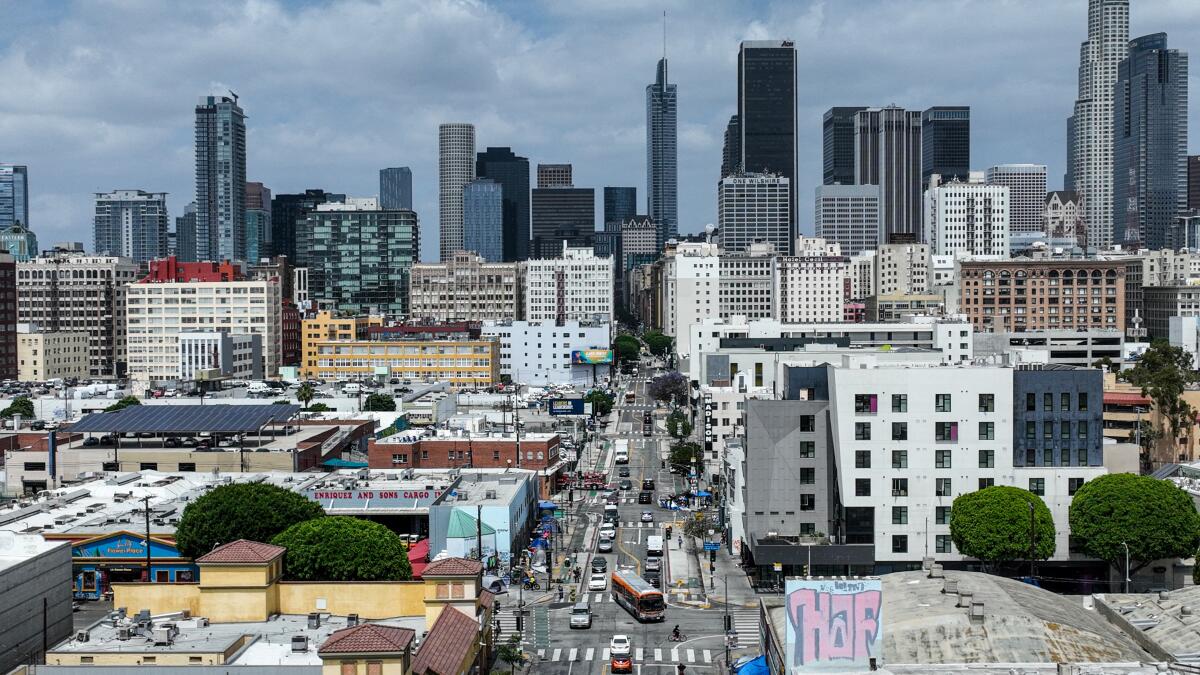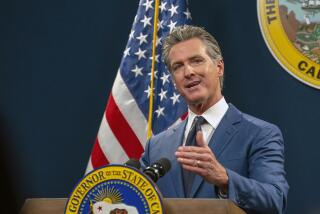California faces an additional $12-billion budget deficit, Newsom says

- Share via
- The Newsom administration is predicting an additional $12-billion budget deficit for 2025-26.
- The shortfall comes in addition to $27.3 billion in remedies Democrats previously agreed to adopt to cover an initial deficit in the upcoming year.
- This marks the third year in a row that Newsom and lawmakers have been forced to trim back their overspending.
California is facing an additional $12-billion state budget shortfall next year, a deficit largely caused by overspending that Gov. Gavin Newsom said was made worse by President Trump’s federal tariff policy.
“California is under assault,” Newsom said. “The United States of America, in many respects, is under assault because we have a president that’s been reckless.”
Newsom unveiled the forecast during a presentation Wednesday of his $321.9-billion revised spending plan that proposes walking back free healthcare for low-income undocumented immigrants, eliminating Medi-Cal benefits for expensive weight loss treatments and cutting back overtime hours for in-home supportive service workers, among dozens of other trims.
The new deficit comes in addition to $27.3 billion in fiscal remedies, including $11.2 billion in cuts and a $7.1-billion withdrawal from the state’s rainy day fund, that lawmakers and the governor already agreed to make in 2025-26.
The overall shortfall marks the third year in a row that Newsom and lawmakers have been forced to reduce funding for state programs after dedicating more money than California has available to spend.
Though Newsom said his plan still provides significant funding for Californians in need of government support, his proposed cuts received fierce pushback from unions and other advocacy groups often allied with Democrats.
“While California leads the fight against Trump’s extremist attacks on our neighbors, our co-workers and our families, we must stand strong behind our values here at home,” said David Huerta, president of SEIU California, in a statement. “Instead, the governor’s proposed budget reads more like a CEO wishlist — sticking it to the working poor to protect tax breaks for the rich, and continuing to hollow out good, middle-class jobs.”
California Gov. Gavin Newsom previewed his $322.2 billion budget proposal for 2025-2026 during a visit Monday to California State University, Stanislaus.
Newsom’s proposed cuts
Among the new cuts Newsom put on the table Wednesday is a call to cut back on his signature policy to provide free healthcare coverage to income-eligible undocumented immigrants.
Newsom is proposing freezing new Medi-Cal enrollment for undocumented adult immigrants as of Jan. 1 and requiring those over 18 to pay $100 monthly premiums to receive healthcare coverage through Medi-Cal beginning in 2027.
The cost share will reduce the financial burden on the state and could lower the total number of people enrolled in the healthcare program if some immigrants cannot afford the new premiums. Freezing enrollment may prevent the price tag of the program from continuing to balloon after more people signed up for coverage than the state anticipated.
The changes offer minor savings next year, which grows to $5.4 billion in 2028-29. The finance department said the cap is expected to result in an enrollment decline of 18,000 patients per month as people exceed income limits or drop out for other reasons and no new applicants are accepted.
Newsom’s budget proposes other cuts to healthcare for immigrants, including saving $333.3 million in 2025-26 by eliminating long-term care benefits for undocumented immigrants and others who are not recognized as citizens under federal law. Adults in that same category would also lose full-scope dental coverage in July 2026.
The California Immigrant Policy Center said the organization was “outraged by the cuts” to Medi-Cal and other funding reductions.
“At a time when Trump and House Republicans are pushing to slash healthcare access and safety net programs while extending tax cuts for the wealthy, California must lead by protecting, not weakening, support for vulnerable communities,” said Masih Fouladi, executive director of CIPC, in a statement.
The governor is following the federal government’s lead and cutting $85 million in benefits for Ozempic and other popular weight loss medications from all Medi-Cal coverage plans.
Newsom also wants to cap overtime hours for in-home support service workers, according to his budget, to save another $707.5 million next year.
The governor’s budget includes a controversial proposal to grab $1.3 billion in funding in 2025-26 from Proposition 35, a measure voters approved in November that dedicated the revenue from a tax on managed care organizations to primarily pay for increases to Medi-Cal provider rates.
The decision drew pushback from a coalition of doctors, clinics, hospitals and other healthcare groups that supported the proposition, which nearly 68% of voters backed. They said the governor’s move “raises serious legal concerns and disregards the will of California voters.”
Planned Parenthood Affiliates of California said the proposed changes in Newsom’s budget would slash the organization’s annual budget in the state by a third.
“Low-income Californians who depend on Planned Parenthood and other safety-net providers will endure longer wait times, have fewer appointment options, need to travel farther distances to access care, and will face even more barriers to accessing reproductive health care,” said Jodi Hicks, president and CEO of Planned Parenthood Affiliates of California, in a statement. “To put it simply, these cuts are plain cruel.”
Under another cost-saving measure, the governor wants to shift $1.5 billion in funding for Cal Fire from the general fund. Instead, Newsom wants to provide that $1.5 billion from the greenhouse gas reduction fund paid for by proceeds of the state cap-and-trade program next year.
The governor’s budget proposes extending the cap-and-trade program — a first-of-its-kind initiative that sets limits on companies’ greenhouse gas emissions and allows them to buy additional credits at auction from the state, and he wants to dedicate at least $1 billion each year to high speed rail.
Newsom also kept his pledge to double California’s film tax credit to $750 million next year.
Jennifer Barrera, president and CEO of the California Chamber of Commerce, said the budget addresses a number of key challenges ahead.
“In these uncertain economic times, CalChamber believes the governor has laid out a reasonable path forward, carefully balancing the need to invest in programs that support the state’s economy with prudent spending reductions that address the gap between revenues and expenditures,” Barrera said in a statement.
During his budget briefing on Wednesday, Newsom quickly dismissed any requests for state financial bailouts for cities or counties facing budget shortfalls, calling that a “nonstarter” given the state’s finances. Los Angeles Mayor Karen Bass came to Sacramento in April to lobby state leaders for money to help close the city’s nearly $1-billion budget hole.
In California, Gov. Gavin Newsom and Democrats in the state Legislature are under pressure to scale back the expansion of state-sponsored healthcare coverage for undocumented immigrants with the cost of the program more the $3 billion over budget.
A spending deficit
The budget marks a continuation of years of overspending in California under the Newsom administration.
After predicting a lofty $100-billion surplus from federal COVID-19 stimulus funding and the resulting economic gains three years ago, Democrats have not reduced spending to match up with a return to normal after the pandemic.
Poor projections, the ballooning cost of Democratic policy promises and a reluctance to make long-term sweeping cuts have added to the deficit at a time when the governor regularly touts California’s place as the fourth-largest economy in the world.
State revenues have exceeded expectations this year, but so has state spending.
Despite the new shortfall, Newsom’s proposal provides the same amount of overall funding for state programs as his January budget and the governor and lawmakers still plan to take $7.1 billion from the state’s rainy day fund to cover the total 2025-26 deficit.
When pressed Wednesday, Newsom acknowledged the state’s spending problem and said it becomes worse in the years beyond 2025-26 when the deficit is expected to grow.
“In that out year, you’re absolutely right, we’ve got a spending problem, and that’s why we need to make these adjustments in the Medicaid budget, and that’s why we have to be a little stubborn now,” Newsom said.
On the eve of his budget presentation, Gov. Gavin Newsom sought to blame President Trump’s tariff policy for reducing California state revenues.
A “Trump Slump”
Though personal income tax and corporate tax receipts in the state came in $6.8 billion above projections through April, Newsom is predicting that overall revenue will be $16 billion lower than it could have been from January 2025 through June 2026 because of the economic impact of Trump’s tariffs.
The governor originally released the new information, which his team dubbed the “Trump Slump,” on the eve of the presentation of his revised 2025-26 state budget plan, seeking to blame the president for California’s expected revenue shortfall.
Trump in April implemented a series of tariffs on all imported goods, higher taxes on products from Mexico, Canada and China, and specific levies on products and materials such as autos and aluminum. The president has backed down from some of his tariffs, but Newsom said that the policies and economic uncertainty will lead to higher unemployment, inflation, lower GDP projections and less capital gains revenue for California.
California filed a lawsuit last month arguing that Trump lacks the authority to impose tariffs on his own. On Tuesday, the state said it will seek a preliminary injunction to freeze the tariffs in federal court.
More to Read
Sign up for Essential California
The most important California stories and recommendations in your inbox every morning.
You may occasionally receive promotional content from the Los Angeles Times.

















